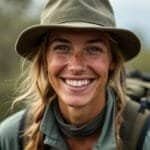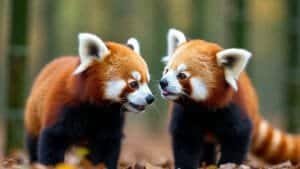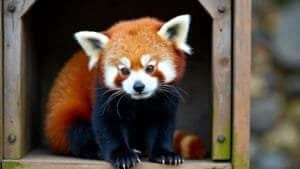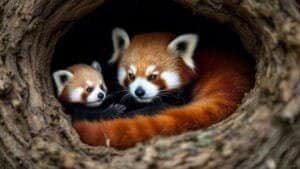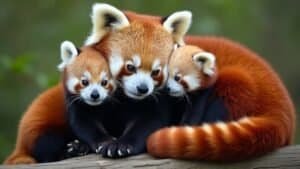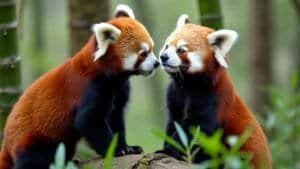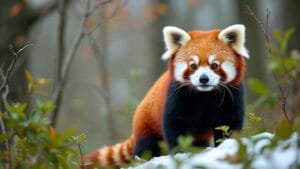Red panda mothers play a vital role in ensuring the survival of their cubs, as these small mammals are born completely dependent on maternal care. From the moment of birth, the mother provides warmth, protection, and nourishment, staying in the nest for extended periods while only leaving briefly to eat. She selects and prepares a secure den using leaves and moss, ensuring a well-insulated environment where her cubs can safely grow.
During the first weeks of life, cubs remain hidden in the den, nursing frequently while their mother grooms them and stimulates their bodily functions. They begin opening their eyes at around three weeks of age, but it takes months before they are strong enough to explore the world outside. As they grow, the mother introduces them to solid food, teaches them climbing techniques, and gradually prepares them for independence
This article explores each stage of red panda maternal care, from birth to cub independence, highlighting the fascinating behaviors that help these vulnerable young thrive
Nesting and Birth Preparations

Red panda mothers invest significant effort in preparing a secure and comfortable environment for their cubs before giving birth. This nesting process is vital for ensuring the survival of newborns, as red panda cubs are born helpless and highly vulnerable to environmental conditions and predators.
How Red Panda Mothers Select and Prepare Their Nest
Several days before giving birth, a female red panda begins searching for a hidden and insulated den. In the wild, she typically chooses tree hollows, rocky crevices, or dense thickets, while in captivity, she may use a nesting box provided by zookeepers. These locations protect the cubs from harsh weather and predators such as leopards and birds of prey
Once a suitable location is found, the mother collects materials to line the nest, ensuring warmth and comfort. She gathers twigs, moss, leaves, bark, and grass, carefully arranging them inside the den. This insulation is particularly important because newborn red panda cubs cannot regulate their body temperature and rely entirely on their mother’s warmth and the nest’s insulation to stay alive
Studies from the San Diego Zoo Wildlife Alliance show that red panda mothers instinctively choose den sites that offer both protection and stable temperatures, as temperature fluctuations can impact cub survival rates. In captivity, conservationists often provide multiple nesting options to allow mothers to select the most suitable environment for their young
Why Nest Insulation Is Essential for Newborn Cubs
Unlike some other mammals, red panda cubs are born with their fur already developed, but they still lack the ability to generate sufficient body heat. This is why their mother’s nest-building efforts are so critical. The thick bedding material inside the den traps warmth, creating a microclimate that protects the cubs from cold temperatures, which can drop significantly in their high-altitude habitats
Additionally, the structure of the nest helps maintain cleanliness. As red panda cubs rely on their mother for grooming and waste removal, a well-maintained den reduces moisture buildup and helps prevent infections. Nest hygiene is a key factor in cub survival, and mothers frequently clean and rearrange their nesting material to keep the environment dry and sanitary
Research from Red Panda Network highlights that in both wild and managed care settings, red panda mothers may move their cubs between multiple nests within the first few weeks. This behavior serves two main purposes:
Reducing the risk of predation by keeping the cubs’ scent from accumulating in one location
Maintaining nest hygiene, ensuring the cubs always have a fresh and clean environment
This instinctive behavior underscores the importance of nest selection and preparation in red panda maternal care, demonstrating the mother’s dedication to ensuring her cubs’ safety and survival. For more insights into red panda maternal instincts, the Red Panda Network article on mother behavior explores the fascinating ways red panda mothers care for their young
Early Maternal Care and Cub Development
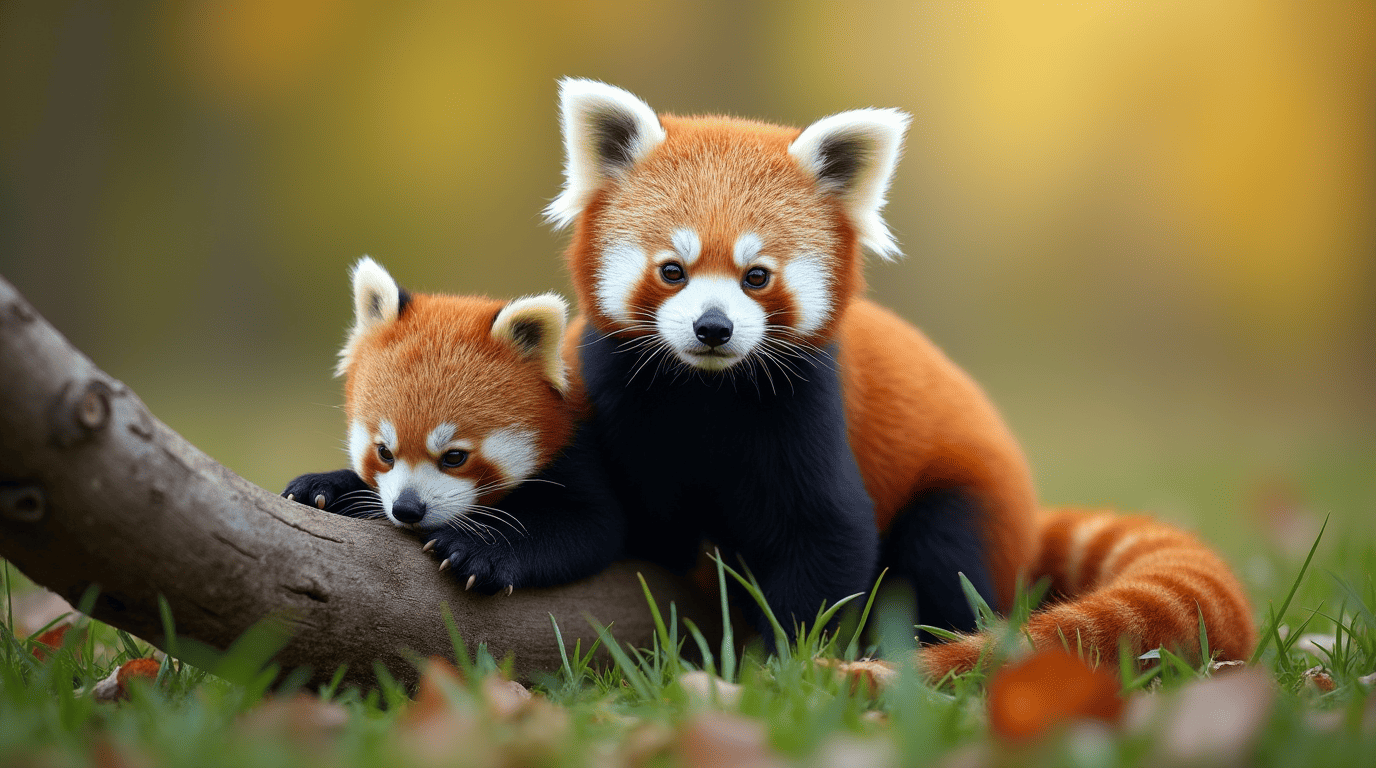
Once red panda cubs are born, they are entirely dependent on their mother for warmth, nourishment, and protection. The first few months of their lives are marked by rapid development, but survival is only possible through constant maternal care
How Often Do Red Panda Cubs Nurse?
Newborn red panda cubs are nursed frequently, as their mother’s milk provides the essential nutrients needed for growth and immune system development. During the first few weeks, cubs nurse every two to four hours, consuming milk that is high in fat and protein to help them gain weight quickly
Since red pandas are solitary animals, the mother does not need to compete for resources, allowing her to devote nearly all her energy to feeding and grooming her cubs. She remains inside the den for long periods, leaving only for brief foraging trips. By the time cubs reach three months old, they begin experimenting with solid foods, but nursing continues until they are about five to six months old. This gradual weaning process ensures that cubs transition smoothly from milk to a diet dominated by bamboo, berries, and small invertebrates
A study conducted at the San Diego Zoo found that captive red panda mothers may adjust their nursing frequency based on environmental conditions, sometimes nursing less frequently in hotter temperatures to prevent overheating inside the den. In the wild, nursing patterns may also be affected by food availability and maternal health
When Do Red Panda Cubs Open Their Eyes?
At birth, red panda cubs are blind and deaf, relying entirely on their sense of touch and smell to locate their mother. Their eyes remain closed for the first few weeks, opening gradually between 18 and 25 days after birth. However, their vision remains weak initially, and they do not start reacting to external stimuli until around one month old
Even after their eyes open, cubs remain inside the nest, as they are not yet strong enough to explore the outside world. The mother keeps them hidden, only interacting with them for feeding and grooming. This protective phase is crucial, as cubs need at least two to three months before they are capable of venturing outside
Observations from San Diego Zoo Wildlife Alliance indicate that cubs in captivity may open their eyes slightly earlier than their wild counterparts, possibly due to more stable environmental conditions. However, their developmental timeline remains largely the same
Early Growth Milestones in the First Few Weeks
The early weeks of a red panda cub’s life are focused on physical and sensory development. Some key milestones include:
Week 1: Cubs are entirely dependent on their mother, nursing frequently and sleeping for most of the day
Week 3: Eyes begin to open, and cubs start showing slight movements within the nest
Week 5-6: Cubs develop their distinctive reddish-brown fur, replacing the grayish coat they are born with
Week 8-10: Cubs begin crawling within the nest, strengthening their muscles for later climbing
Month 3: Cubs take their first steps outside the nest, beginning to explore under their mother’s supervision
During these early weeks, maternal grooming plays a vital role. The mother licks her cubs regularly, stimulating blood circulation and aiding in digestion. She also consumes their waste to maintain nest cleanliness, a behavior observed in many carnivorous mammals
For a deeper look at red panda cub growth stages, the San Diego Zoo’s red panda facts page provides additional insights into their development from birth to independence
Protection, Weaning, and Independence
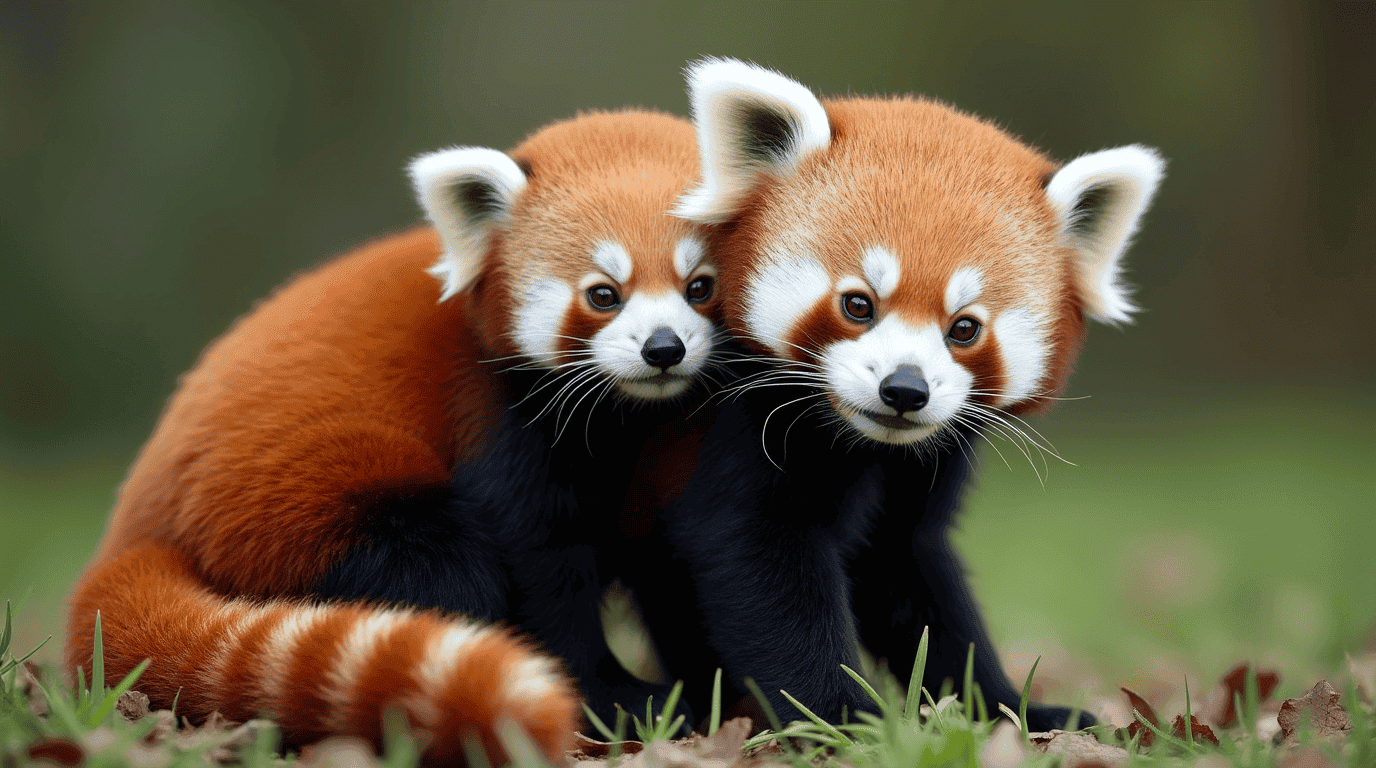
As red panda cubs grow, their mother continues to provide guidance, protection, and nutrition until they are ready to survive on their own. This phase involves learning key survival skills, transitioning to solid food, and eventually becoming independent
How Red Panda Mothers Protect Their Cubs From Predators
Red panda cubs are highly vulnerable during their first few months of life, as they are unable to defend themselves or escape threats. Their mother plays a critical role in keeping them safe through a combination of nest selection, relocation, and protective behaviors
Strategic Nest Placement: Red panda mothers choose nesting sites that are hidden and hard to access, such as high tree hollows or dense undergrowth. This reduces the likelihood of predators—such as leopards, birds of prey, and martens—discovering the cubs
Frequent Nest Relocation: To further minimize risk, the mother may move her cubs to a new nest every few weeks. This behavior prevents scents from accumulating in one location, which could attract predators
Limited Time Away: During the first month, the mother spends 60% to 90% of her time inside the nest, only leaving briefly to eat. This ensures that cubs are rarely left unprotected
Defensive Behavior: If threatened, a red panda mother will use her sharp claws and teeth to defend her cubs. Though red pandas are generally shy, a mother will act aggressively if she perceives danger
This combination of strategies helps ensure that cubs survive long enough to gain independence. Observations from San Diego Zoo Wildlife Alliance confirm that captive red panda mothers exhibit the same protective instincts, even in environments where predators are absent
When Do Cubs Start Eating Solid Food?
At around 50 to 60 days old, red panda cubs begin chewing on small pieces of bamboo, though they still rely on their mother’s milk for most of their nutrition. The transition to solid food happens gradually, allowing their digestive system to adapt. By 90 days of age, cubs start eating bamboo regularly, as well as small amounts of fruit, berries, and insects. In captivity, young red pandas are also introduced to specialized biscuits to ensure they receive proper nutrients.
Weaning is usually complete by 13 to 22 weeks (about three to five months old), at which point the cubs consume solid food almost exclusively. This marks a key step toward independence, as they begin relying less on their mother for nourishment
How Long Do Cubs Stay With Their Mother?
Red panda cubs remain under their mother’s care for approximately eight months, during which they learn essential survival skills. The mother teaches them:
Climbing Techniques: Cubs practice climbing trees and navigating rocky terrain, which are crucial for escaping predators and finding food
Foraging Skills: The mother demonstrates how to strip bamboo leaves, locate berries, and find small prey like insects
Territorial Behavior: Cubs learn to recognize scent markings and establish their own territory when they become independent
At around six months of age, cubs start venturing farther from the nest, exploring their surroundings with more confidence. However, they still sleep near their mother and rely on her guidance
When Do Red Panda Cubs Become Independent?
By eight to ten months old, red panda cubs reach full independence. In the wild, they begin establishing their own territory, while in captivity, young red pandas are usually separated from their mother to prevent conflicts. Red pandas are naturally solitary animals, so even siblings do not typically stay together after reaching maturity. By 18 to 20 months old, red pandas become sexually mature, though they usually do not breed until they are two years old
For more details on how red panda cubs transition to adulthood, the Red Panda Network’s article on maternal behavior provides further insights

